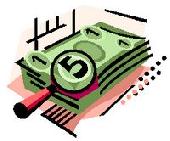
 |
|
| Financial Terms | |
| Current Dollars |
|
Information about financial, finance, business, accounting, payroll, inventory, investment, money, inventory control, stock trading, financial advisor, tax advisor, credit.
Main Page: stock trading, investment, financial advisor, finance, business, financial, inventory control, accounting, |
Definition of Current Dollars
Current DollarsA variable like GDP is measured in current dollars if each year's value is measured in prices prevailing during that year. In contrast, when measured in real or constant dollars, each year's value is measured in a base year's prices.
Related Terms:Current accountNet flow of goods, services, and unilateral transactions (gifts) between countries. Current assetsValue of cash, accounts receivable, inventories, marketable securities and other assets that Current couponA bond selling at or close to par, that is, a bond with a coupon close to the yields currently Current liabilitiesAmount owed for salaries, interest, accounts payable and other debts due within 1 year. Current issueIn Treasury securities, the most recently auctioned issue. Trading is more active in current Current maturitycurrent time to maturity on an outstanding debt instrument. Current rate methodUnder this currency translation method, all foreign currency balance-sheet and income  Current ratioIndicator of short-term debt paying ability. Determined by dividing current assets by current Current yieldFor bonds or notes, the coupon rate divided by the market price of the bond. Current-coupon issuesRelated: Benchmark issues Other current assetsValue of non-cash assets, including prepaid expenses and accounts receivable, due Soft dollarsThe value of research services that brokerage houses supply to investment managers "free of Current assetsCash, things that will be converted into cash within a year (such as accounts receivable), and inventory. Current liabilitiesBills a company must pay within the next twelve months. Current ratioA ratio that shows how many times a company could pay its current debts if it used its current assets to pay them. The formula: Current assetsAmounts receivable by the business within a period of 12 months, including bank, debtors, inventory and prepayments. Current liabilitiesAmounts due and payable by the business within a period of 12 months, e.g. bank overdraft, creditors and accruals. current assetscurrent refers to cash and those assets that will be turned current liabilitiescurrent means that these liabilities require payment in current ratioCalculated to assess the short-term solvency, or debt-paying Current RatioA measure of the ability of a company to use its current assets to concurrent engineeringsee simultaneous engineering Current assetTypically the cash, accounts receivable, and inventory accounts on the Current costUnder target costing concepts, this is the cost that would be applied to a Current liabilityThis is typically the accounts payable, short-term notes payable, and current yieldAnnual coupon payments divided by bond price. eurodollarsdollars held on deposit in a bank outside the United States. Constant dollarsSee real dollars. Current AccountThat part of the balance of payments accounts that records demands for and supplies of a currency arising from activities that affect current income, namely imports, exports, investment income payments such as interest and dividends, and transfers such as gifts, pensions, and foreign aid. Current YieldThe percentage return on a financial asset based on the current price of the asset, without reference to any expected change in the price of the asset. This contrasts with yield-to-maturity, for which the calculation includes expected price changes. See also yield. EurodollarsDeposits denominated in U.S. dollars but held in banks located outside the United States, such as in Canada or France. Current Tax Payment Act of 1943A federal Act requiring employers to withhold income taxes from employee pay. Current Income Tax ExpenseThat portion of the total income tax provision that is based on Current AssetsCash and other company assets that can be readily turned into cash within one year. Current LiabilitiesDebts or other obligations coming due within a year. Current Ratiocurrent assets divided by current liabilities. This ratio indicates the extent to which the claims of short-term creditors are covered by assets expected to be converted to cash in the near future. Regulation MFed regulation currently requiring member banks to hold reserves against their net borrowings NominalMeasured in money terms, in current rather than real dollars. Contrast with real. Related to : financial, finance, business, accounting, payroll, inventory, investment, money, inventory control, stock trading, financial advisor, tax advisor, credit. |